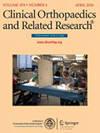Factors That Increase the Risk of Prosthetic Joint Infection Within 90 Days After THA and TKA: A Nationwide Population-based Study.
IF 4.2
2区 医学
Q1 ORTHOPEDICS
引用次数: 0
Abstract
BACKGROUND Prosthetic joint infection (PJI) after THA and TKA is a serious complication. Although previous studies have identified risk factors for overall and late-onset PJI, limited research has focused specifically on infections occurring within the immediate 90-day postoperative period, a time frame critical for assessing surgical quality and early recovery outcomes. QUESTIONS/PURPOSES What patient and clinical factors are associated with the development of PJI within 90 days after primary THA or TKA? METHODS This was a retrospective, controlled study drawn from a longitudinally maintained, large, national database (the Taiwan National Health Insurance Research Database [NHIRD]). The NHIRD, covering > 99% of the population, provides comprehensive data for reliably identifying and tracking postoperative complications such as PJIs. Patients who underwent THA or TKA between January 2016 and December 2017 were identified. Only patients with complete follow-up data for at least 90 days after surgery, based on insurance records, were eligible for inclusion. The primary outcome was PJI within 90 days, defined as the presence of an ICD-10-Clinical Modification (CM) diagnosis code for PJI recorded in claims within 90 days of the index THA or TKA procedure. A total of 13,442 patients who underwent THA and 40,245 patients who underwent TKA were included. The PJI rate within 90 days was 0.61% (82 of 13,442) for THA and 0.58% (232 of 40,245) for TKA. Cox regression analyses were used to estimate associations between potential demographic and clinical factors and the risk of PJI within 90 days. RESULTS After adjusting for age, sex, diabetes, and other clinically relevant factors, we found that the adjusted HR (aHR) for PJI within 90 days after THA was higher among patients who were male (aHR 2.49 [95% confidence interval (CI) 1.38 to 4.48]; p < 0.01), had a longer length of stay (aHR 1.06 [95% CI 1.04 to 1.09]; p < 0.01), had osteoarthritis (aHR 0.48 [95% CI 0.27 to 0.87]; p = 0.01) or avascular necrosis of the femoral head (aHR 0.43 [95% CI 0.22 to 0.84]; p = 0.01), had diabetes mellitus (aHR 3.72 [95% CI 2.21 to 6.26]; p < 0.01), had hepatitis B infection (aHR 2.44 [95% CI 1.11 to 5.36]; p = 0.03), and had hepatitis C infection (aHR 2.76 [95% CI 1.14 to 6.66]; p = 0.02). The aHR for PJI within 90 days after TKA was higher for patients who were younger than 65 years (aHR 1.57 [95% CI 1.18 to 2.08]; p < 0.01), male (aHR 2.05 [95% CI 1.55 to 2.71]; p < 0.01), had a longer length of stay (aHR 1.09 [95% CI 1.08 to 1.11]; p < 0.01), had osteoporosis (aHR 1.44 [95% CI 1.08 to 1.92]; p = 0.01), and had chronic kidney disease (aHR 1.50 [95% CI 1.06 to 2.11]; p = 0.02). The aHR was lower for patients who had bilateral TKA (aHR 0.31 [95% CI 0.12 to 0.84]; p = 0.02) compared with those who had unilateral TKA only. CONCLUSION Male sex, diabetes, hepatitis C, osteoporosis, chronic kidney disease, and younger age after TKA were associated with a higher risk of PJI within 90 days. The findings indicate that surgeons may enhance perioperative infection prevention efforts in these high-risk patients by optimizing glycemic control, improving perioperative medical management, minimizing surgical time and blood loss when possible, and ensuring rigorous postoperative wound surveillance. Future large-scale observational studies are needed to refine individualized risk prediction and assess the effectiveness of targeted preventive strategies in real-world clinical practice. LEVEL OF EVIDENCE Level III, therapeutic study.全髋关节置换术和全髋关节置换术后90天内增加人工关节感染风险的因素:一项基于全国人群的研究
背景:全髋关节置换术和全髋关节置换术后假体关节感染是严重的并发症。虽然以前的研究已经确定了整体和晚发性PJI的危险因素,但有限的研究专门关注术后90天内发生的感染,这是评估手术质量和早期恢复结果的关键时间框架。问题/目的:哪些患者和临床因素与原发性THA或TKA术后90天内PJI的发生相关?NHIRD覆盖了99%的人口,为可靠地识别和跟踪pji等术后并发症提供了全面的数据。确定了2016年1月至2017年12月期间接受THA或TKA的患者。根据保险记录,只有术后90天随访数据完整的患者才有资格纳入研究。主要结局是90天内的PJI,定义为在THA或TKA手术后90天内记录的icd -10临床修改(CM) PJI诊断代码的存在。共纳入13442例THA患者和40245例TKA患者。90天内PJI率THA为0.61%(13442例中82例),TKA为0.58%(40245例中232例)。使用Cox回归分析来估计潜在的人口学和临床因素与90天内PJI风险之间的关联。结果在校正了年龄、性别、糖尿病和其他临床相关因素后,我们发现男性患者THA后90天内PJI的调整HR (aHR)更高(aHR 2.49[95%可信区间(CI) 1.38 ~ 4.48];p < 0.01),住院时间较长(aHR 1.06 [95% CI 1.04 ~ 1.09];p < 0.01),有骨关节炎(aHR 0.48 [95% CI 0.27 ~ 0.87];p = 0.01)或股骨头缺血性坏死(aHR 0.43 [95% CI 0.22 ~ 0.84];p = 0.01),有糖尿病(aHR 3.72 [95% CI 2.21 ~ 6.26];p < 0.01)、乙型肝炎感染(aHR 2.44 [95% CI 1.11 ~ 5.36];p = 0.03),并有丙型肝炎感染(aHR 2.76 [95% CI 1.14 ~ 6.66];P = 0.02)。年龄小于65岁的患者TKA后90天内PJI的aHR较高(aHR 1.57 [95% CI 1.18 ~ 2.08];p < 0.01),男性(aHR 2.05 [95% CI 1.55 ~ 2.71];p < 0.01),住院时间较长(aHR 1.09 [95% CI 1.08 ~ 1.11];p < 0.01),骨质疏松(aHR 1.44 [95% CI 1.08 ~ 1.92];p = 0.01),并有慢性肾脏疾病(aHR 1.50 [95% CI 1.06 ~ 2.11];P = 0.02)。双侧TKA患者的aHR较低(aHR为0.31 [95% CI 0.12 ~ 0.84];p = 0.02),与单侧TKA组比较。结论男性、糖尿病、丙型肝炎、骨质疏松、慢性肾脏疾病、TKA后年龄较小与90天内PJI发生风险增高相关。研究结果表明,外科医生可以通过优化血糖控制,改善围手术期医疗管理,尽可能减少手术时间和出血量,并确保严格的术后伤口监测来加强这些高危患者围手术期感染预防工作。未来需要大规模的观察性研究来完善个性化的风险预测,并评估在现实世界的临床实践中有针对性的预防策略的有效性。证据等级:III级,治疗性研究。
本文章由计算机程序翻译,如有差异,请以英文原文为准。
求助全文
约1分钟内获得全文
求助全文
来源期刊
CiteScore
7.00
自引率
11.90%
发文量
722
审稿时长
2.5 months
期刊介绍:
Clinical Orthopaedics and Related Research® is a leading peer-reviewed journal devoted to the dissemination of new and important orthopaedic knowledge.
CORR® brings readers the latest clinical and basic research, along with columns, commentaries, and interviews with authors.

 求助内容:
求助内容: 应助结果提醒方式:
应助结果提醒方式:


